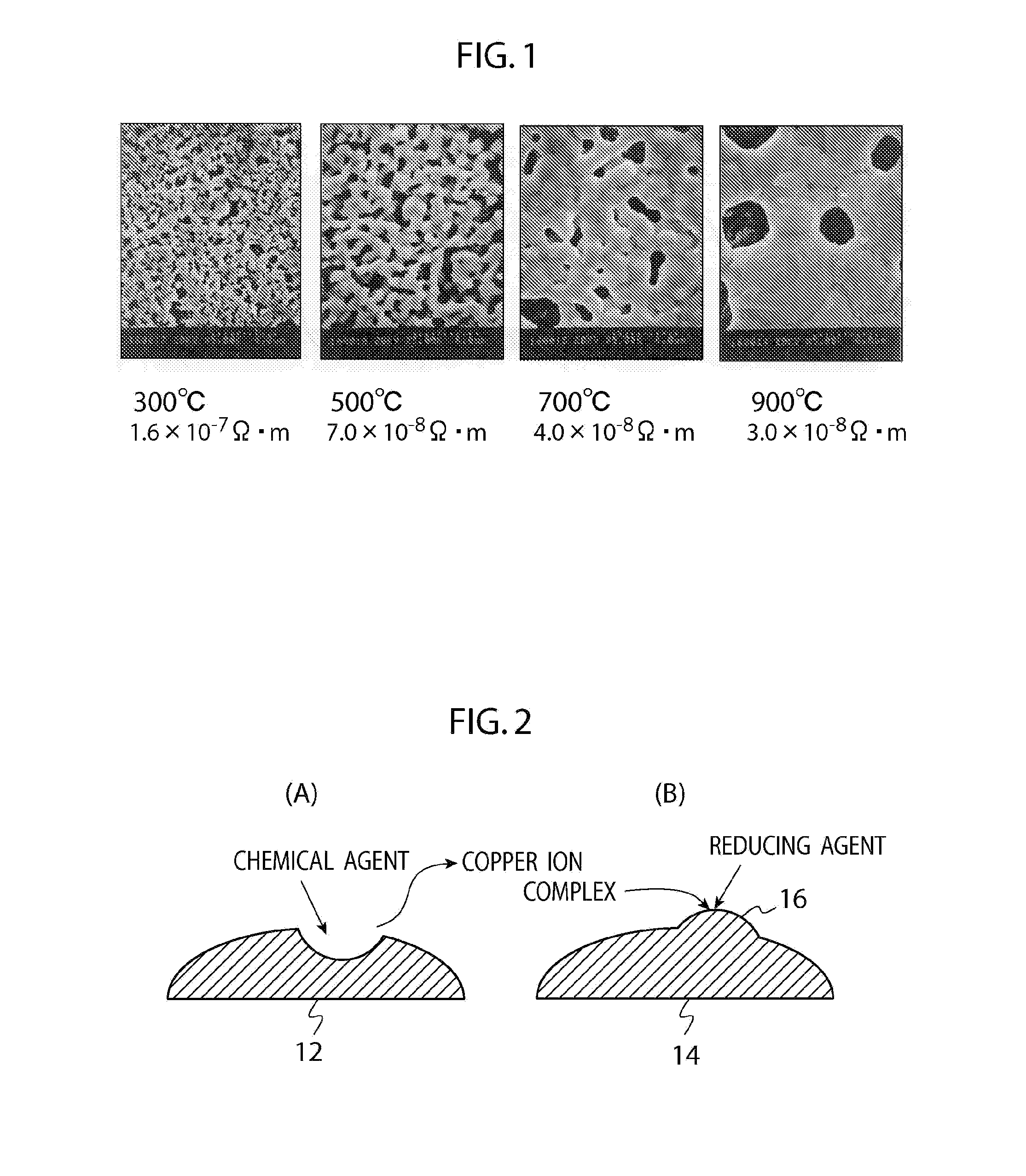Copper conductor film and manufacturing method thereof, conductive substrate and manufacturing method thereof, copper conductor wiring and manufacturing method thereof, and treatment solution
a manufacturing method and copper conductor technology, applied in the direction of resistive material coating, solid-state device coating, metallic material coating process, etc., can solve the problem of increasing the unit price of superfine printing dispersion slurry, the inability to print wiring having a line width not more than the particle diameter, and the inability to form fine wiring patterns. , to achieve the effect of not causing a fall in electric conductance, excellent conductivity and wiring pattern formation
- Summary
- Abstract
- Description
- Claims
- Application Information
AI Technical Summary
Benefits of technology
Problems solved by technology
Method used
Image
Examples
example 1
[0283]As a substrate on which copper nanoparticles were deposited, the following was used: a substrate having a copper nanoparticle deposited layer (copper based particle containing layer) yielded by painting a 5% by mass dispersion slurry of copper nanoparticles (trial product, manufactured by Fukuda Metal Foil & Powder Co., Ltd.), produced in a solution by a laser ablation process, in γ-butyrolactone onto a polyimide substrate (trade name: MCF-5000I, manufactured by Hitachi Chemical Co., Ltd.) having copper patterns in FIG. 4 by means of an applicator, and then repeating the drying of the resultant at 100° C. under a nitrogen atmosphere 3 times.
[0284]It is understood from Auger electron spectroscopy and STEM-EDX observation that the present particles had a core / shell structure wherein a copper oxide layer was present around metallic copper.
[0285]A solution prepared by weighing in accordance with column 1 in Table 1 was used as a treatment solution. The substrate having the copper ...
example 2
[0288]In accordance with the blend table (column 2 in Table 1), a substrate as used in Example 1, which had a deposit film of the copper nanoparticles, was prepared. The substrate was treated with a treatment solution for conversion to a conductor (treatment solution) neither containing 2,2′ bipyridyl nor EDTA in the same way as in Example 1. As a result, in the concentrically-circular copper patterns having gaps of 1 mm, 2 mm and 5 mm, respectively, resistances of 25 Ω, 28Ω and 238Ω were shown, respectively; thus, high electroconductivity was shown.
example 3
[0289]In accordance with the blend table (column 3 in Table 1), a substrate as used in Example 1, which had a deposit film of the copper nanoparticles, was prepared. The substrate was treated with a treatment solution for conversion to a conductor (treatment solution) using ethylenediamine instead of ammonia in the same way as in Example 1. As a result, in the concentrically-circular copper patterns having gaps of 1 mm, 2 mm and 5 mm, respectively, resistances of 9.8 MΩ, and 131Ω were shown, respectively; thus, electroconductivity was shown.
PUM
| Property | Measurement | Unit |
|---|---|---|
| Electrical conductor | aaaaa | aaaaa |
| Catalytic activity | aaaaa | aaaaa |
| Molar ratio | aaaaa | aaaaa |
Abstract
Description
Claims
Application Information
 Login to View More
Login to View More - R&D
- Intellectual Property
- Life Sciences
- Materials
- Tech Scout
- Unparalleled Data Quality
- Higher Quality Content
- 60% Fewer Hallucinations
Browse by: Latest US Patents, China's latest patents, Technical Efficacy Thesaurus, Application Domain, Technology Topic, Popular Technical Reports.
© 2025 PatSnap. All rights reserved.Legal|Privacy policy|Modern Slavery Act Transparency Statement|Sitemap|About US| Contact US: help@patsnap.com



